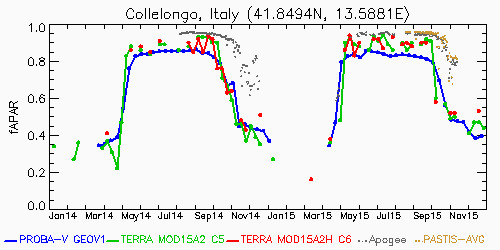Validation of PROBA-V GEOV1 and MODIS C5 & C6 fAPAR Products in a Deciduous Beech Forest Site in Italy
Abstract
:1. Introduction
2. Remote Sensing Product
2.1. GEOV1
2.2. MODIS C5
2.3. MODIS C6
2.4. Product Quality Flag
3. Materials and Methods
3.1. Study Site
3.2. Temporal and Spatial Sampling
3.3. Ground Measurements and Instruments
3.3.1. PAR Measurements from Apogee
3.3.2. PAR Measurements from PASTIS
3.3.3. Gap Fraction Estimation from DHP
3.4. Calculation of Ground Canopy fAPAR
3.4.1. Estimation of fAPAR from Apogee (fAPARAPOGEE)
3.4.2. Estimation of fAPAR from PASTIS (fAPARPASTIS)
3.4.3. Estimation of fAPAR from DHPs
3.5. Validation Approach
3.5.1. Empirical Transfer Function
3.5.2. Spatial Aggregation
3.5.3. Correlation Analysis
4. Results
4.1. Consistency of Ground fAPAR Estimates
4.2. High-Resolution Ground-Based Maps
4.3. Validation of Satellite fAPAR Products
4.3.1. Product Quality Flag Analysis
4.3.2. Temporal Consistency
4.3.3. Accuracy Assessment
5. Discussion
5.1. Consistency of Ground fAPAR Estimates
5.2. Accuracy Assessment
6. Conclusions
Acknowledgments
Author Contributions
Conflicts of Interest
References
- Pettorelli, N.; Vik, J.O.; Mysterud, A.; Gaillard, J.M.; Tucker, C.J.; Stenseth, N.C. Using the satellite-derived NDVI to assess ecological responses to environmental change. Trends Ecol. Evol. 2005, 20, 503–510. [Google Scholar] [CrossRef] [PubMed]
- GTOS 52. Terrestrial Essential Climate Variables for Climate Change Assessment, Mitigation and Adaptation; Food and Agriculture Organization, United Nations: Rome, Italy, 2008. [Google Scholar]
- Gobron, N.; Verstraete, M.M. ECV T10: Fraction of Absorbed Photosynthetically Active Radiation (FAPAR); Food and Agriculture Organization, United Nations: Rome, Italy, 2009. [Google Scholar]
- Weiss, M.; Baret, F. fAPAR (fraction of Absorbed Photosynthetically Active Radiation) estimates at various scale. In Proceedings of the 34th International Symposium for Remote Sensing of the Environment (ISRSE), Sydney, Australia, 10–15 April 2011.
- Weiss, M.; Baret, F.; Garrigues, S.; Lacaze, R. LAI and fAPAR CYCLOPES global products derived from VEGETATION. Part 2: Validation and comparison with MODIS collection 4 products. Remote Sens. Environ. 2007, 110, 317–331. [Google Scholar] [CrossRef]
- Asner, G.P.; Wessman, C.A.; Archer, S. Scale Dependence of Absorption of Photosynthetically Active Radiation in Terrestrial Ecosystems. Ecol. Appl. 1998, 8, 1003–1021. [Google Scholar] [CrossRef]
- Gobron, N.; Pinty, B.; Taberner, M.; Mélin, F.; Verstraete, M.M.; Widlowski, J.L. Monitoring the photosynthetic activity of vegetation from remote sensing data. Adv. Space Res. 2006, 38, 2196–2202. [Google Scholar] [CrossRef]
- Gond, V.; De Pury, D.G.G.; Veroustraete, F.; Ceulemans, R. Seasonal variations in leaf area index, leaf chlorophyll, and water content; scaling-up to estimate fAPAR and carbon balance in a multilayer, multispecies temperate forest. Tree Physiol. 1999, 19, 673–679. [Google Scholar] [CrossRef] [PubMed]
- Gobron, N.; Pinty, B.; Mélin, F.; Taberner, M.; Verstraete, M.M.; Belward, A.; Lavergne, T.; Widlowski, J.L. The state of vegetation in Europe following the 2003 drought. Int. J. Remote Sens. 2005, 26, 2013–2020. [Google Scholar] [CrossRef]
- Senna, M.C.A. Fraction of photosynthetically active radiation absorbed by Amazon tropical forest: A comparison of field measurements, modeling, and remote sensing. J. Geophys. Res. 2005, 110, 1–8. [Google Scholar] [CrossRef]
- Field, C.B.; Randerson, J.T.; Malmström, C.M. Global net primary production: Combining ecology and remote sensing. Remote Sens. Environ. 1995, 51, 74–88. [Google Scholar] [CrossRef]
- Jung, M.; Verstraete, M.; Gobron, N.; Reichstein, M.; Papale, D.; Bondeau, A.; Robustelli, M.; Pinty, B. Diagnostic assessment of European gross primary production. Glob. Chang. Biol. 2008, 14, 2349–2364. [Google Scholar] [CrossRef]
- Seixas, J.; Carvalhais, N.; Nunes, C.; Benali, A. Comparative analysis of MODIS-FAPAR and MERIS-MGVI datasets: Potential impacts on ecosystem modeling. Remote Sens. Environ. 2009, 113, 2547–2559. [Google Scholar] [CrossRef]
- McCallum, I.; Wagner, W.; Schmullius, C.; Shvidenko, A.; Obersteiner, M.; Fritz, S.; Nilsson, S. Satellite-based terrestrial production efficiency modeling. Carbon Balance Manag. 2009, 4, 8. [Google Scholar] [CrossRef] [PubMed]
- Gower, S.T.; Kucharik, C.J.; Norman, J.M. Direct and indirect estimation of leaf area index, fAPAR, and net primary production of terrestrial ecosystems. Remote Sens. Environ. 1999, 70, 29–51. [Google Scholar] [CrossRef]
- Lobell, D.B.; Asner, G.P.; Ortiz-Monasterio, J.I.; Benning, T.L. Remote sensing of regional crop production in the Yaqui Valley, Mexico: Estimates and uncertainties. Agric. Ecosyst. Environ. 2003, 94, 205–220. [Google Scholar] [CrossRef]
- Hanan, N.P.; Bégué, A. A method to estimate instantaneous and daily intercepted photosynthetically active radiation using a hemispherical sensor. Agric. For. Meteorol. 1995, 74, 55–168. [Google Scholar] [CrossRef]
- Widlowski, J.L. On the bias of instantaneous FAPAR estimates in open-canopy forests. Agric. For. Meteorol. 2011, 150, 1501–1522. [Google Scholar] [CrossRef]
- Myneni, R.B.; Williams, D.L. On the relationship between FAPAR and NDVI. Remote Sens. Environ. 1994, 49, 200–211. [Google Scholar] [CrossRef]
- Running, S.W.; Nemani, R.R.; Heinsch, F.A.; Zhao, M.; Reeves, M.; Hashimoto, H. A continuous satellite-derived measure of global terrestrial primary production. Bioscience 2004, 54, 547–560. [Google Scholar] [CrossRef]
- Xiao, X.; Zhang, Q.; Hollinger, D.; Aber, J.; Moore, B., III. Modelling gross primary production of an evergreen needleleaf forest using modis and climate data. Ecol. Appl. 2005, 15, 954–969. [Google Scholar] [CrossRef]
- Wu, C.; Munger, J.W.; Niu, Z.; Kuang, D. Comparison of multiple models for estimating gross primary production using MODIS and eddy covariance data in Harvard Forest. Remote Sens. Environ. 2010, 114, 2925–2939. [Google Scholar] [CrossRef]
- Myneni, R.B.; Hoffman, S.; Knyazikhin, Y.; Privette, J.L.; Glassy, J.; Tian, Y.; Wang, Y.; Song, X.; Zhang, Y.; Smith, G.R.; et al. Global products of vegetation leaf area and fraction absorbed PAR from year one of MODIS data. Remote Sens. Environ. 2002, 83, 214–231. [Google Scholar] [CrossRef]
- Zhang, Q.; Xiao, X.; Braswell, B.; Linder, E.; Baret, F.; Moore, B. Estimating light absorption by chlorophyll, leaf and canopy in a deciduous broadleaf forest using MODIS data and a radiative transfer model. Remote Sens. Environ. 2005, 99, 357–371. [Google Scholar] [CrossRef]
- Knyazikhin, Y.; Martonchik, J.V.; Myneni, R.B.; Diner, D.J.; Running, S.W. Synergistic algorithm for estimating vegetation canopy leaf area index and fraction of absorbed photosynthetically active radiation from MODIS and MISR data. J. Geophys. Res. 1998, 103, 32257–32276. [Google Scholar] [CrossRef]
- Gobron, N.; Pinty, B.; Aussedat, O.; Chen, J.M.; Cohen, W.B.; Fensholt, R.; Gond, V.; Huemmrich, K.F.; Lavergne, T.; Mélin, F.; et al. Evaluation of fraction of absorbed photosynthetically active radiation products for different canopy radiation transfer regimes: Methodology and results using Joint Research Center products derived from SeaWiFS against ground-based estimations. J. Geophys. Res. Atmos. 2006, 111, 1–15. [Google Scholar] [CrossRef]
- Plummer, S.; Arino, O.; Simon, M.; Steffen, W. Establishing a earth observation product service for the terrestrial carbon community: The globcarbon initiative. Mitig. Adapt. Strateg. Glob. Chang. 2006, 11, 97–111. [Google Scholar] [CrossRef]
- Pinty, B.; Lavergne, T.; Voßbeck, M.; Kaminski, T.; Aussedat, O.; Giering, R.; Gobron, N.; Taberner, M.; Verstraete, M.M.; Widlowski, J.L. Retrieving surface parameters for climate models from Moderate Resolution Imaging Spectroradiometer (MODIS)-Multiangle Imaging Spectroradiometer (MISR) albedo products. J. Geophys. Res. Atmos. 2007, 112, 1–23. [Google Scholar] [CrossRef]
- Baret, F.; Hagolle, O.; Geiger, B.; Bicheron, P.; Miras, B.; Huc, M.; Berthelot, B.; Niño, F.; Weiss, M.; Samain, O.; et al. LAI, fAPAR and fCover CYCLOPES global products derived from VEGETATION. Part 1: Principles of the algorithm. Remote Sens. Environ. 2007, 110, 275–286. [Google Scholar] [CrossRef] [Green Version]
- Donohue, R.J.; Roderick, M.L.; McVicar, T.R. Deriving consistent long-term vegetation information from AVHRR reflectance data using a cover-triangle-based framework. Remote Sens. Environ. 2008, 112, 2938–2949. [Google Scholar] [CrossRef]
- Baret, F.; Weiss, M.; Lacaze, R.; Camacho, F.; Makhmara, H.; Pacholcyzk, P.; Smets, B. GEOV1: LAI and FAPAR essential climate variables and FCOVER global time series capitalizing over existing products. Part1: Principles of development and production. Remote Sens. Environ. 2013, 137, 299–309. [Google Scholar] [CrossRef]
- Camacho, F.; Cernicharo, J.; Lacaze, R.; Baret, F.; Weiss, M. GEOV1: LAI, FAPAR essential climate variables and FCOVER global time series capitalizing over existing products. Part 2: Validation and intercomparison with reference products. Remote Sens. Environ. 2013, 137, 310–329. [Google Scholar] [CrossRef]
- Yang, W.; Tan, B.; Huang, D.; Rautiainen, M.; Shabanov, N.V.; Wang, Y.; Privette, J.L.; Huemmrich, K.F.; Fensholt, R.; Sandholt, I.; et al. MODIS leaf area index products: From validation to algorithm improvement. IEEE Trans. Geosci. Remote Sens. 2006, 44, 1885–1896. [Google Scholar] [CrossRef]
- Martínez, B.; Camacho, F.; Verger, A.; García-Haro, F.J.; Gilabert, M.A. Intercomparison and quality assessment of MERIS, MODIS and SEVIRI FAPAR products over the Iberian Peninsula. Int. J. Appl. Earth Obs. Geoinf. 2013, 21, 463–476. [Google Scholar] [CrossRef]
- Pickett-Heaps, C.A.; Canadell, J.G.; Briggs, P.R.; Gobron, N.; Haverd, V.; Paget, M.J.; Pinty, B.; Raupach, M.R. Evaluation of six satellite-derived Fraction of Absorbed Photosynthetic Active Radiation (FAPAR) products across the Australian continent. Remote Sens. Environ. 2014, 140, 241–256. [Google Scholar] [CrossRef]
- McCallum, A.; Wagner, W.; Schmullius, C.; Shvidenko, A.; Obersteiner, M.; Fritz, S.; Nilsson, S. Comparison of four global FAPAR datasets over Northern Eurasia for the year 2000. Remote Sens. Environ. 2010, 114, 941–949. [Google Scholar] [CrossRef]
- Yan, K.; Park, T.; Yan, G.; Chen, C.; Yang, B.; Liu, Z.; Nemani, R.; Knyazikhin, Y.; Myneni, R. Evaluation of MODIS LAI/FPAR Product Collection 6. Part 1: Consistency and Improvements. Remote Sens. 2016, 8, 359. [Google Scholar] [CrossRef]
- Yan, K.; Park, T.; Yan, G.; Liu, Z.; Yang, B.; Chen, C.; Nemani, R.; Knyazikhin, Y.; Myneni, R. Evaluation of MODIS LAI/FPAR Product Collection 6. Part 2: Validation and Intercomparison. Remote Sens. 2016, 8, 460. [Google Scholar] [CrossRef]
- D’Odorico, P.; Gonsamo, A.; Pinty, B.; Gobron, N.; Coops, N.; Mendez, E.; Schaepman, M.E. Intercomparison of fraction of absorbed photosynthetically active radiation products derived from satellite data over Europe. Remote Sens. Environ. 2014, 142, 141–154. [Google Scholar] [CrossRef]
- Majasalmi, T.; Rautiainen, M.; Stenberg, P.; Manninen, T. Validation of MODIS and GEOV1 fPAR products in a boreal forest site in Finland. Remote Sens. 2015, 7, 1359–1379. [Google Scholar] [CrossRef]
- Tao, X.; Liang, S.; Wang, D. Assessment of five global satellite products of fraction of absorbed photosynthetically active radiation: Intercomparison and direct validation against ground-based data. Remote Sens. Environ. 2015, 163, 270–285. [Google Scholar] [CrossRef]
- Weiss, M.; Baret, F.; Block, T.; Koetz, B.; Burini, A.; Scholze, B.; Lecharpentier, P.; Brockmann, C.; Fernandes, R.; Plummer, S.; et al. On line validation exercise (OLIVE): A web based service for the validation of medium resolution land products. application to FAPAR products. Remote Sens. 2014, 6, 4190–4216. [Google Scholar] [CrossRef]
- Morisette, J.T.; Baret, F.; Privette, J.L.; Myneni, R.B.; Nickeson, J.; Garrigues, S.; Shabanov, N.; Weiss, M.; Fernandes, R.; Leblanc, S.; et al. Validation of Global Moderate-Resolution LAI Products: A Framework Proposed Within the CEOS Land Product Validation Subgroup. IEEE Trans. Geosci. Remote Sens. 2006, 44, 1–14. [Google Scholar] [CrossRef]
- The Global Climate Observing System. Systematic Observation Requirements for Satellite-Based Data Products for Climate—2011 Update; The Global Climate Observing System: Geneva, Switzerland, 2011. [Google Scholar]
- GIO Global Land Component—Lot I “Operation of the Global Land Component”, Framework Service Contract N° 388533 (JRC), Product User Manual, Fraction of Absorbed Photosynthetically Active Radiation (FAPAR)—Version 1. Available online: http://land.copernicus.eu/global/sites/default/files/products/GIOGL1_ATBD_FAPARV1_I1.10.pdf (accessed on 13 November 2016).
- Hagolle, O.; Lobo, A.; Maisongrande, P.; Cabot, F.; Duchemin, B.; De Pereyra, A. Quality assessment and improvement of temporally composited products of remotely sensed imagery by combination of VEGETATION 1 and 2 images. Remote Sens. Environ. 2005, 94, 172–186. [Google Scholar] [CrossRef] [Green Version]
- Sánchez, J.; Camacho, F.; Lacaze, R.; Smets, B. Early validation of PROBA-V GEOV1 LAI, FAPAR and FCOVER products for the continuity of the Copernicus Global Land Service. Int. Arch. Photogramm. Remote Sens. Spat. Inf. Sci. 2015, XL-7/W3, 93–100. [Google Scholar] [CrossRef]
- Vermote, E.F.; Tanrè, D.; Deuzè, J.L.; Herman, M.; Morcrette, J.J. Second Simulation of the Satellite Signal in the Solar Spectrum, 6s: An Overview. IEEE Trans. Geosci. Remote Sens. 1997, 35, 675–686. [Google Scholar] [CrossRef]
- Cohen, W.B.; Maiersperger, T.K.; Turner, D.P.; Ritts, W.D.; Pflugmacher, D.; Kennedy, R.E.; Kirschbaum, A.; Running, S.W.; Costa, M.; Gower, S.T. MODIS Land Cover and LAI Collection 4 Product Quality Across Nine Sites in the Western Hemisphere. IEEE Trans. Geosci. Remote Sens. 2006, 44, 1843–1857. [Google Scholar] [CrossRef]
- Steinberg, D.C.; Goetz, S.J.; Hyer, E.J. Validation of MODIS FPAR products in boreal forests of alaska. IEEE Trans. Geosci. Remote Sens. 2006, 44, 1818–1828. [Google Scholar] [CrossRef]
- Pisek, J.; Chen, J.M. Comparison and validation of MODIS and VEGETATION global LAI products over four BigFoot sites in North America. Remote Sens. Environ. 2007, 109, 81–94. [Google Scholar] [CrossRef]
- Garrigues, S.; Lacaze, R.; Baret, F.; Morisette, J.T.; Weiss, M.; Nickeson, J.E.; Fernandes, R.; Plummer, S.; Shabanov, N.V.; Myneni, R.B.; Knyazikhin, Y. Validation and intercomparison of global Leaf Area Index products derived from remote sensing data. J. Geophys. Res. 2008, 113, 1–20. [Google Scholar] [CrossRef]
- Fang, H.; Wei, S.; Jiang, C.; Scipal, K. Theoretical uncertainty analysis of global MODIS, CYCLOPES, and GLOBCARBON LAI products using a triple collocation method. Remote Sens. Environ. 2012, 124, 610–621. [Google Scholar] [CrossRef]
- Scartazza, A.; Mata, C.; Matteucci, G.; Yakir, D.; Moscatello, S.; Brugnoli, E. Comparisons of δ13 C of photosynthetic products and ecosystem respiratory CO2 and their responses to seasonal climate variability. Oecologia 2004, 140, 340–351. [Google Scholar] [CrossRef] [PubMed]
- Aubinet, M.; Grelle, A.; Ibrom, A.; Rannik, U.; Moncrieff, J.; Foken, T.; Kowalski, A.S.; Martin, P.H.; Berbigier, P.; Bernhofer, C.; et al. Estimates of the annual net carbon and water exchange of forests: The EUROFLUX methodology. Adv. Ecol. Res. 2000, 30, 113–175. [Google Scholar]
- Matteucci, G.; Masci, A.; Valentini, R.; Scarascia, G. The response of forests to global change: measurements and modelling simulations in a mountain forest of the Mediterranean region. In Scientific Tools and Research Needs for Multifunctional Mediterranean Forest Ecosystem Management; Palahi, M., Byrot, Y., Rois, M., Eds.; European Forest Institute (EFI) Proceedings: Joensuu, Finland, 2007; pp. 11–23. [Google Scholar]
- Chiti, T.; Papale, D.; Smith, P.; Dalmonech, D.; Matteucci, G.; Yeluripati, J.; Rodeghiero, M.; Valentini, R. Predicting changes in soil organic carbon in mediterranean and alpine forests during the Kyoto Protocol commitment periods using the CENTURY model. Soil Use Manag. 2010, 26, 475–484. [Google Scholar] [CrossRef]
- Scartazza, A.; Di Baccio, D.; Bertolotto, P.; Gavrichkova, O.; Matteucci, G. Investigating the European beech (Fagus sylvatica L.) leaf characteristics along the vertical canopy profile: leaf structure, photosynthetic capacity, light energy dissipation and photoprotection mechanisms. Tree Physiol. 2016, 36, 1060–1076. [Google Scholar] [CrossRef] [PubMed]
- Guidolotti, G.; Rey, A.; D’andrea, E.; Matteucci, G.; De Angelis, P. Effect of environmental variables and stand structure on ecosystem respiration components in a Mediterranean beech forest. Tree Physiol. 2013, 33, 960–972. [Google Scholar] [CrossRef] [PubMed]
- Scartazza, A.; Moscatello, S.; Matteucci, G.; Battistelli, A.; Brugnoli, E. Seasonal and inter-annual dynamics of growth, non-structural carbohydrates and C stable isotopes in a Mediterranean beech forest. Tree Physiol. 2013, 33, 730–742. [Google Scholar] [CrossRef] [PubMed]
- Apogee Instruments Inc. Owner’s Manual. Apogee Instruments. Quantum sensor (Models SQ-110 and SQ-300 Series); Apogee Instruments Inc.: Logan, UT, USA, 2016; pp. 1–17. [Google Scholar]
- Weiss, M.; Baret, F.; De Solan, B.; Hemmerlé, M. Monitoring Plant Area Index at ground level: PAI autonomous system from transmittance sensors (PASTIS). In Fourth Recent Advances in Quantitative Remote Sensing; Sobrino, J.A., Ed.; Publicacions de la Universitat de València: València, Spain, 2014. [Google Scholar]
- Weiss, M.; Baret, F. CAN-EYE User Manual. V6.313. 2014. Available online: https://www6.paca.inra.fr/can-eye/Documentation-Publications/Documentation (accessed on 30 October 2016).
- Weiss, M.; Baret, F.; Smith, G.J.; Jonckheere, I.; Coppin, P. Review of methods for in situ leaf area index (LAI) determination. Agric. For. Meteorol. 2004, 121, 37–53. [Google Scholar]
- Liang, S.; Li, X.; Wang, J. Fraction of absorbed photosynthetically active radiation by green vegetation. In Advanced Remote Sensing: Terrestrial Information Extraction and Applications; Elsevier Inc.: Oxford, UK, 2012; pp. 383–414. [Google Scholar]
- Wang, Y.; Xie, D.; Liu, S.; Hu, R.; Li, Y.; Yan, G. Scaling of FAPAR from the Field to the Satellite. Remote Sens. 2016, 8, 310. [Google Scholar] [CrossRef]
- Zhang, Q.; Middleton, E.M.; Cheng, Y.B.; Landis, D.R. Variations of foliage chlorophyll fAPAR and foliage non-chlorophyll fAPAR (fAPARchl, fAPARnonchl) at the Harvard Forest. IEEE J. Sel. Top. Appl. Earth Obs. Remote Sens. 2013, 6, 2254–2264. [Google Scholar] [CrossRef]
- Jonckheere, I.; Fleck, S.; Nackaerts, K.; Muys, B.; Coppin, P.; Weiss, M.; Baret, F. Review of methods for in situ leaf area index determination Part I. Theories, sensors and hemispherical photography. Agric. For. Meteorol. 2004, 121, 19–35. [Google Scholar] [CrossRef]
- Andrieu, B.; Baret, F. Indirect methods of estimating crop structure from optical measurements. In Crop Structure and Light Microclimate—Characterization and Applications; Varlet-Grancher, R.B.C., Sinoquet, H., Eds.; INRA: Paris, France, 1993; pp. 285–322. [Google Scholar]
- Weiss, M. CAN-EYE Output Variables. Definitions and Theoretical Background. Available online: https://www4.paca.inra.fr/can-eye/Documentation-Publications/Documentation (accessed on 13 November 2016).
- Martínez, B.; García-Haro, F.J.; Camacho-de Coca, F. Derivation of high-resolution leaf area index maps in support of validation activities: Application to the cropland Barrax site. Agric. For. Meteorol. 2009, 149, 130–145. [Google Scholar] [CrossRef]
- Gamon, J.A.; Field, C.B.; Goulden, M.L.; Griffin, K.L.; Hartley, A.E.; Joel, G.; Peñuelas, J.; Valentini, R. Relationships Between NDVI, Canopy Structure, and Photosynthesis in Three Californian Vegetation Types. Ecol. Appl. 1995, 5, 28–41. [Google Scholar] [CrossRef]
- Goward, S.N.; Huemmrich, K.F. Vegetation canopy PAR absorptance and the normalized difference vegetation index - An assessment using the SAIL model. Remote Sens. Environ. 1992, 39, 119–140. [Google Scholar] [CrossRef]
- Nestola, E.; Calfapietra, C.; Emmerton, C.; Wong, C.; Thayer, D.; Gamon, J. Monitoring Grassland Seasonal Carbon Dynamics, by Integrating MODIS NDVI, Proximal Optical Sampling, and Eddy Covariance Measurements. Remote Sens. 2016, 8, 260. [Google Scholar] [CrossRef]
- Myneni, R.B.; Hall, F.G.; Sellers, P.J.; Marshak, A.L. The interpretation of spectral vegetation indexes. IEEE Trans. Geosci. Remote Sens. 1995, 33, 481–486. [Google Scholar] [CrossRef]
- Fensholt, R.; Sandholt, I.; Rasmussen, M.S. Evaluation of MODIS LAI, fAPAR and the relation between fAPAR and NDVI in a semi-arid environment using in situ measurements. Remote Sens. Environ. 2004, 91, 490–507. [Google Scholar] [CrossRef]
- Rouse, J.W.; Haas, R.H.; Schell, J.A.; Deering, D.W. Monitoring vegetation systems in the Great Plains with ERTS. In Third Earth Resources Technology Satellite-1 Symposium; NASA: Washington, DC, USA, 1974; pp. 309–317. [Google Scholar]
- Ronchetti, E.; Field, C.; Blanchard, W. Robust linear model selection by cross-validation. J. Am. Stat. Assoc. 1997, 92, 1017–1023. [Google Scholar] [CrossRef]
- Latorre, C. Vegetation Field Data and Production of Ground-Based Maps: “Collelongo Site—Selvapiana, Italy” 8th July and 25th September, 2015. Available online: http://fp7-imagines.eu/media/Documents/ImagineS_RP7.5_FieldCampaign_Collelongo2015_I1.00.pdf (accessed on 13 September 2016).
- Mira, M.; Weiss, M.; Baret, F.; Courault, D.; Hagolle, O.; Gallego-Elvira, B.; Olioso, A. The MODIS (collection V006) BRDF/albedo product MCD43D: Temporal course evaluated over agricultural landscape. Remote Sens. Environ. 2015, 170, 216–228. [Google Scholar] [CrossRef]
- Schowengerdt, R.A. Remote Sensing: Models and Methods for Image Processing, 3rd ed.; Academic Press: San Diego, CA, USA, 2007. [Google Scholar]
- Duveiller, G.; Baret, F.; Defourny, P. Crop specific green area index retrieval from MODIS data at regional scale by controlling pixel-target adequacy. Remote Sens. Environ. 2011, 115, 2686–2701. [Google Scholar] [CrossRef]
- Fernandes, R.; Plummer, S.; Nightingale, J.; Baret, F.; Camacho, F.; Fang, H.; Garrigues, S.; Gobron, N.; Lang, M.; Lacaze, R.; et al. Global Leaf Area Index Product Validation Good Practices. In Best Practice for Satellite-Derived Land Product Validation. Land Product Validation Subgroup (WGCV/CEOS); Schaepman-Strub, G., Román, M., Nickeson, J., Eds.; Working Group on Calibration & Validation (WGCV); Committee on Earth Observation Satellites (CEOS): Zurich, Switzerland, 2014; pp. 1–78. [Google Scholar]
- Harper, W.V. Reduced major axis regression: Teaching alternatives to least squares. In Sustainability in Statistics Education. Proceedings of the Ninth International Conference on Teaching Statistics (ICOTS9), Flagstaff, AZ, USA, 13–18 July 2014; Makar, K., De Sousa, B., Gould, R., Eds.; International Statistical Instutute: Voorburg, The Netherlands, 2014; pp. 1–4. [Google Scholar]
- Camacho, F.; Lacaze, R.; Latorre, C.; Baret, F.; De la Cruz, F.; Demarez, V.; Di Bella, C.; Fang, H.; García-Haro, J.; Gonzalez, M.P.; et al. A Network of Sites for Ground Biophysical Measurements in support of Copernicus Global Land Product Validation. In Fourth Recent Advances in Quantitative Remote Sensing; Sobrino, J., Ed.; Publicacions de la Universitat de València: València, Spain, 2014; pp. 1–6. [Google Scholar]
- Latorre, C.; Camacho, F.; De la Cruz, F.; Lacaze, R.; Weiss, M.; Baret, F. Seasonal monitoring of FAPAR over the Barrax cropland site in Spain , in support of the validation of PROBA-V products at 333 m. In Fourth Recent Advances in Quantitative Remote Sensing; Sobrino, J.A., Ed.; Publicacions de la Universitat de València: València, Spain, 2014; pp. 1–6. [Google Scholar]
- Garrigues, S.; Shabanov, N.V.; Swanson, K.; Morisette, J.T.; Baret, F.; Myneni, R.B. Intercomparison and sensitivity analysis of Leaf Area Index retrievals from LAI-2000, AccuPAR, and digital hemispherical photography over croplands. Agric. For. Meteorol. 2008, 148, 1193–1209. [Google Scholar] [CrossRef]
- Sharma, A.; Jose, S.; Bohn, K.K.; Andreu, M.G. Effects of reproduction methods and overstory species composition on understory light availability in longleaf pine-slash pine ecosystems. For. Ecol. Manag. 2012, 284, 23–33. [Google Scholar] [CrossRef]
- Raymaekers, D.; Garcia, A.; Di Bella, C.; Beget, M.E.; Llavallol, C.; Oricchio, P.; Straschnoy, J.; Weiss, M.; Baret, F. SPOT-VEGETATION GEOV1 biophysical parameters in semi-arid agro-ecosystems. Int. J. Remote Sens. 2014, 35, 2534–2547. [Google Scholar] [CrossRef]
- Mougin, E.; Demarez, V.; Diawara, M.; Hiernaux, P.; Soumaguel, N.; Berg, A. Estimation of LAI, fAPAR and fCover of Sahel rangelands (Gourma, Mali). Agric. For. Meteorol. 2014, 198, 155–167. [Google Scholar] [CrossRef]
- Campos-Taberner, M.; García-Haro, F.J.; Confalonieri, R.; Martinez, B.; Moreno, Á.; Sánchez-Ruiz, S.; Gilabert, M.A.; Camacho, F.; Boschetti, M.; Busetto, L. Multitemporal monitoring of plant area index in the valencia rice district with PocketLAI. Remote Sens. 2016, 8, 1–17. [Google Scholar] [CrossRef]
- Brunet, J.; Fritz, Ö.; Richnau, G. Biodiversity in European beech forests—A review with recommendations for sustainable forest management. Ecol. Bull. 2010, 53, 77–94. [Google Scholar]
- Cohen, W.B.; Maiersperger, T.K.; Gower, S.T.; Turner, D.P. An improved strategy for regression of biophysical variables and Landsat ETM+ data. Remote Sens. Environ. 2003, 84, 561–571. [Google Scholar] [CrossRef]
- Knyazikhin, Y.; Glassy, J.; Privette, J.L.; Tian, Y.; Lotsch, A.; Zhang, Y.; Wang, Y.; Morisette, J.T.; Votava, P.; Myneni, R.B.; et al. MODIS Leaf Area Index (LAI) And Fraction Of Photosynthetically Active Radiation Absorbed By Vegetation (FPAR) Product. Algorithm Theoretical Basis Document. Available online: https://modis.gsfc.nasa.gov/data/atbd/atbd_mod15.pdf (accessed on 28 December 2016).
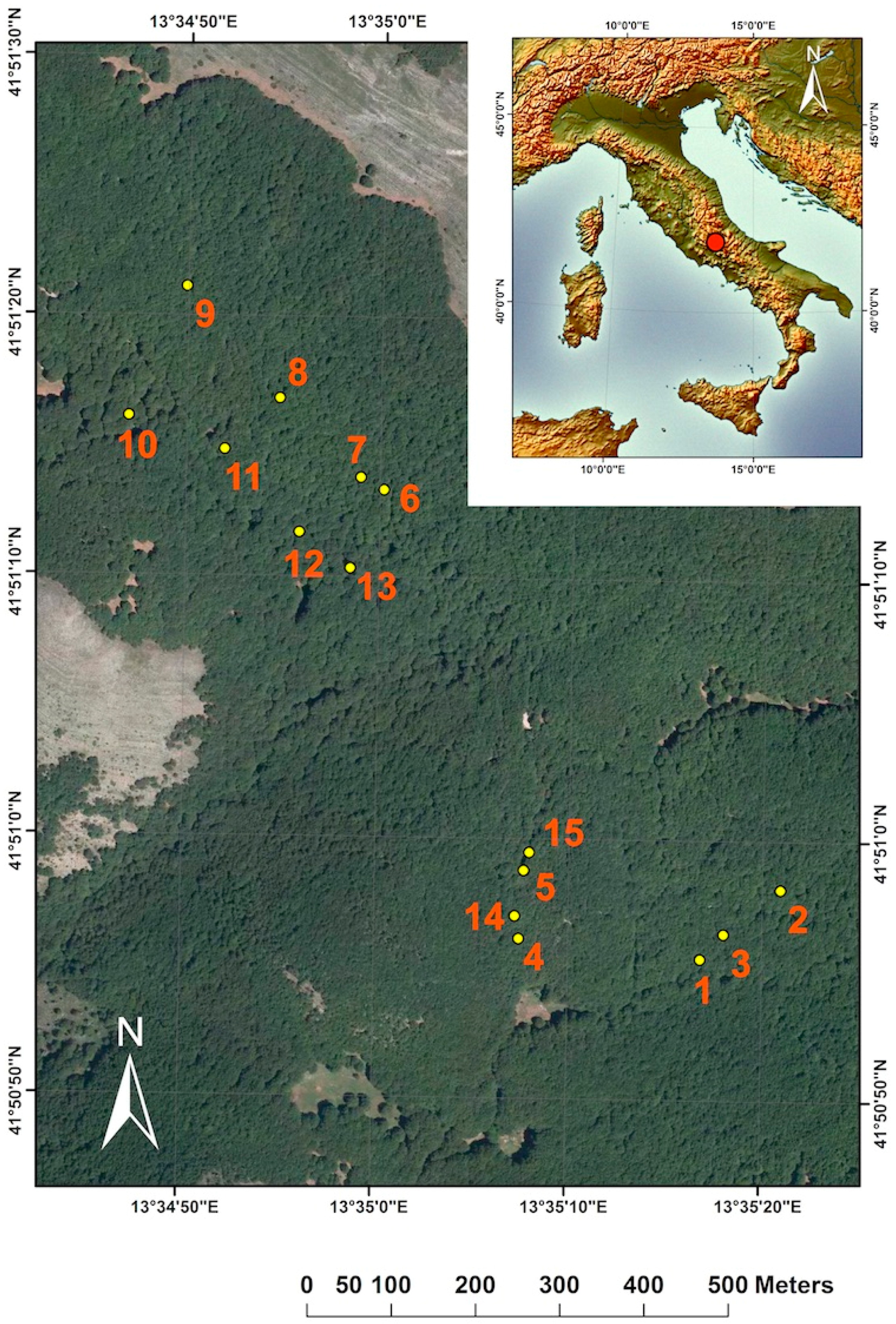

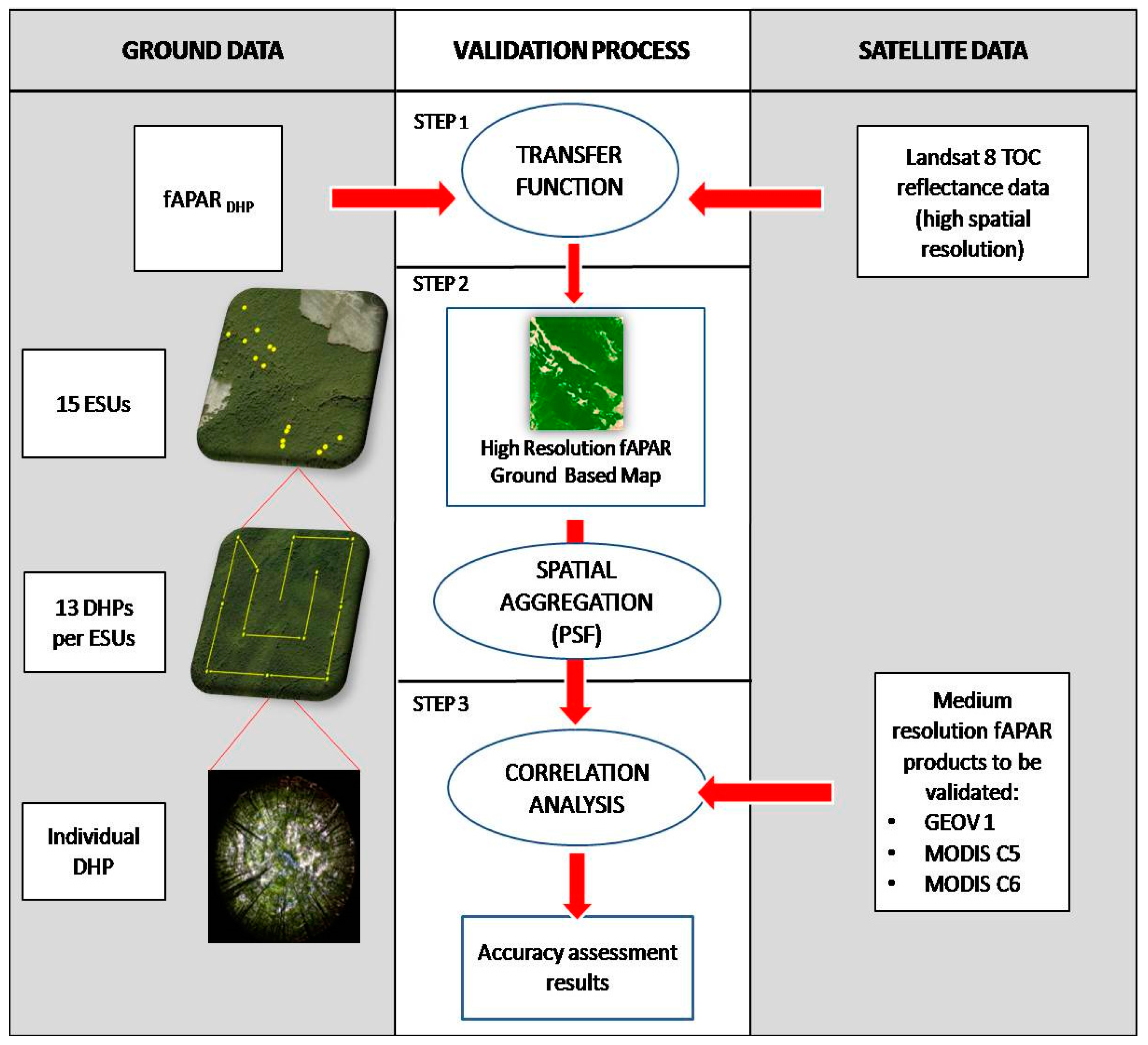
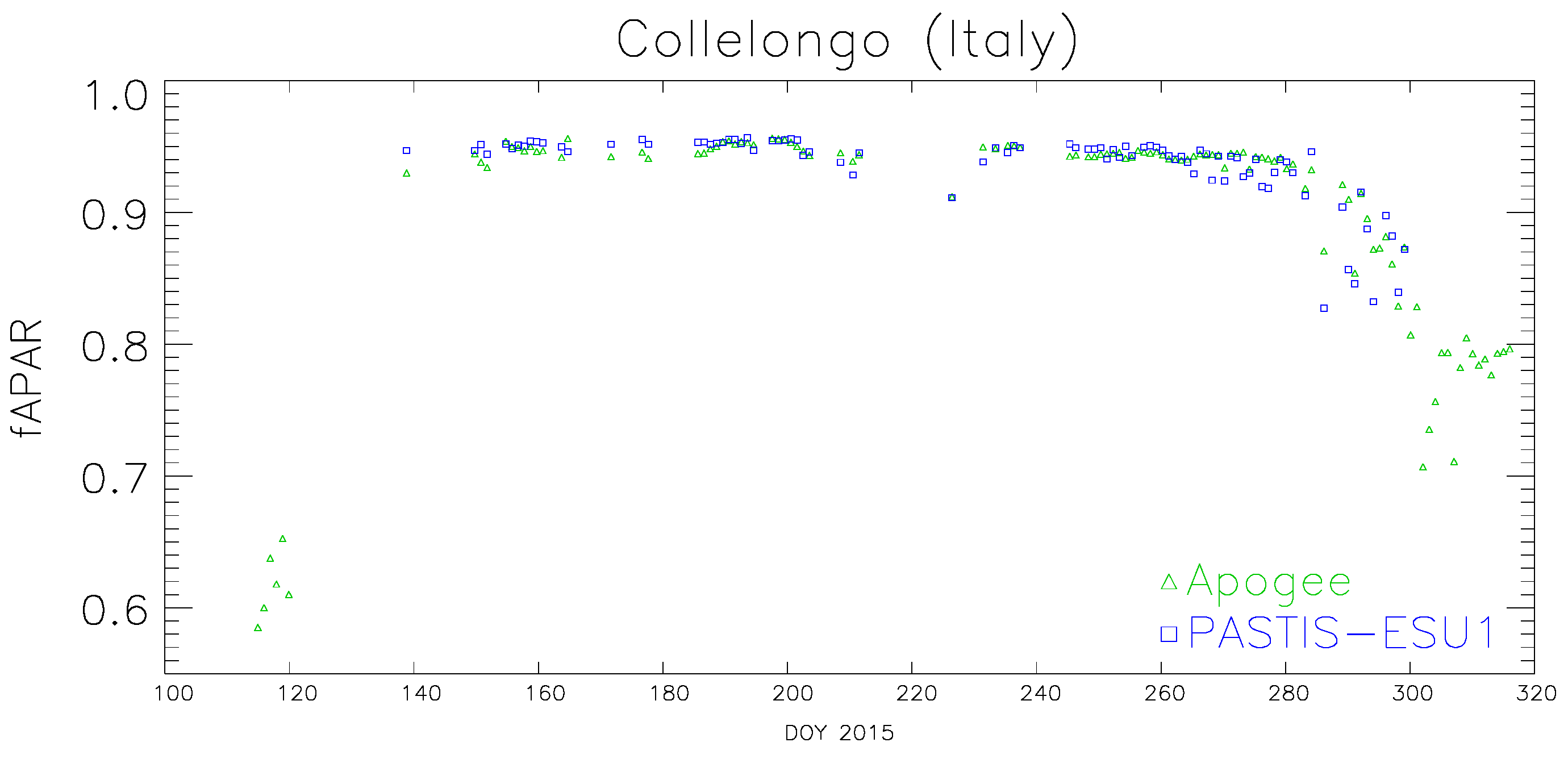

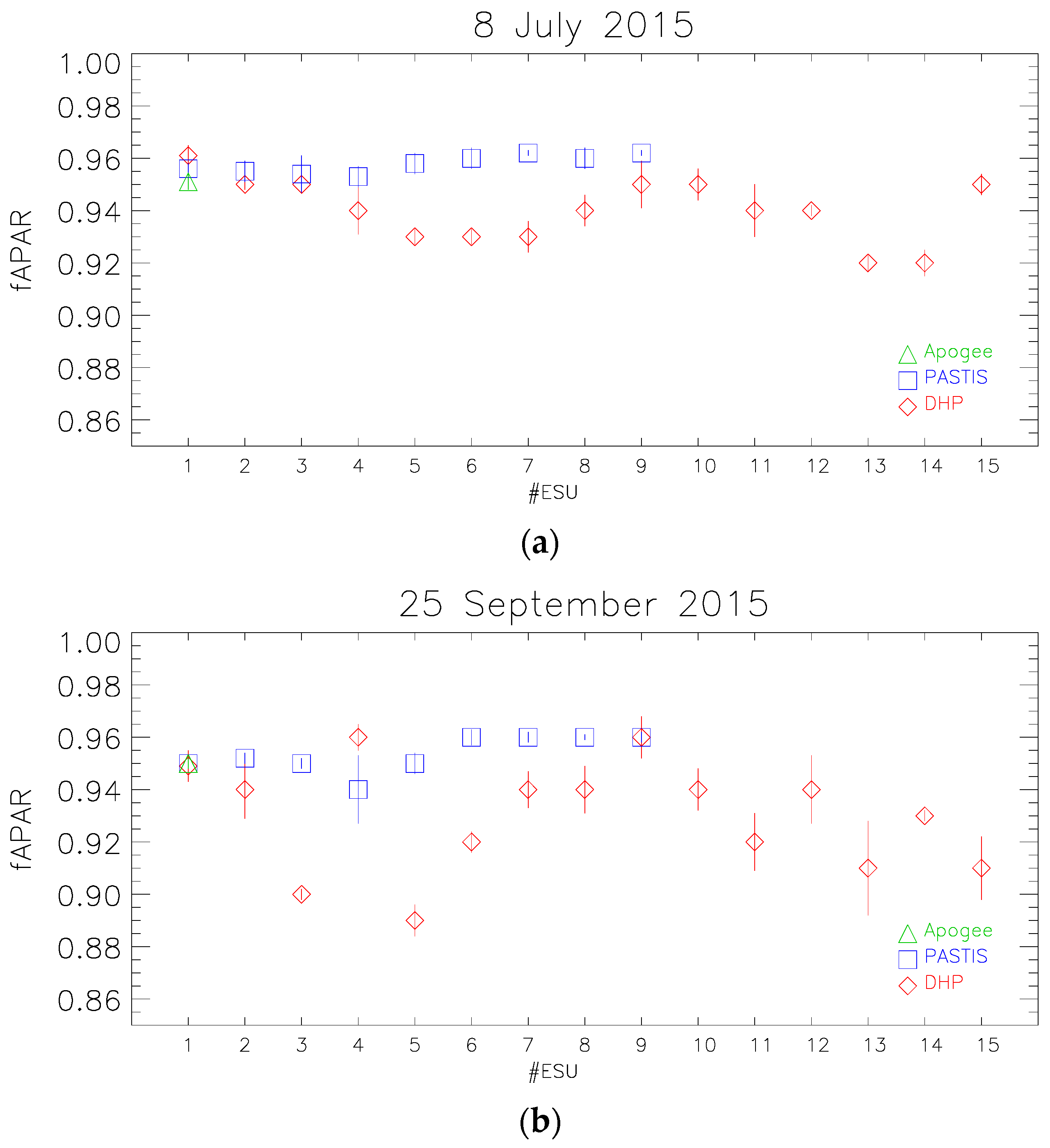
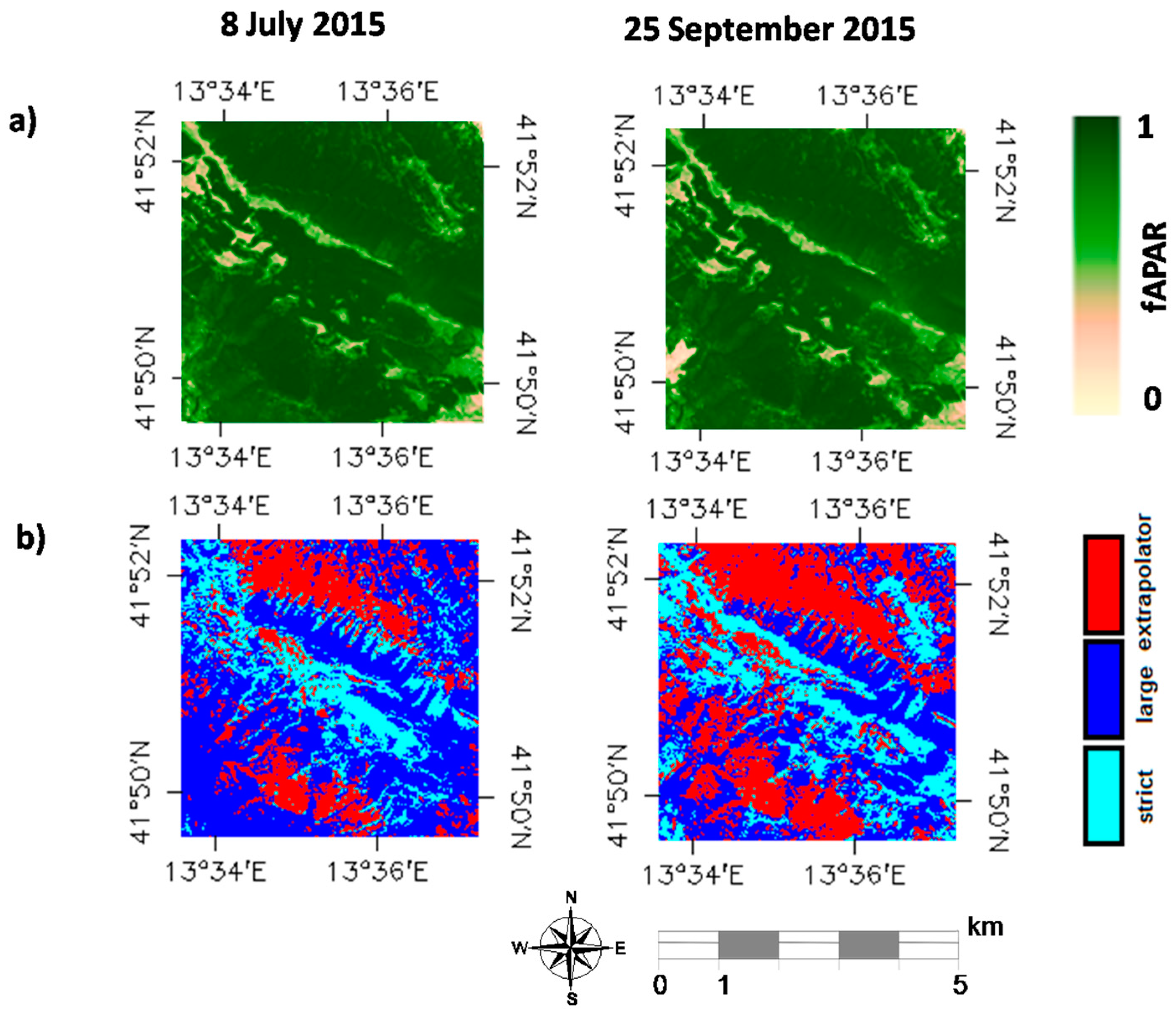

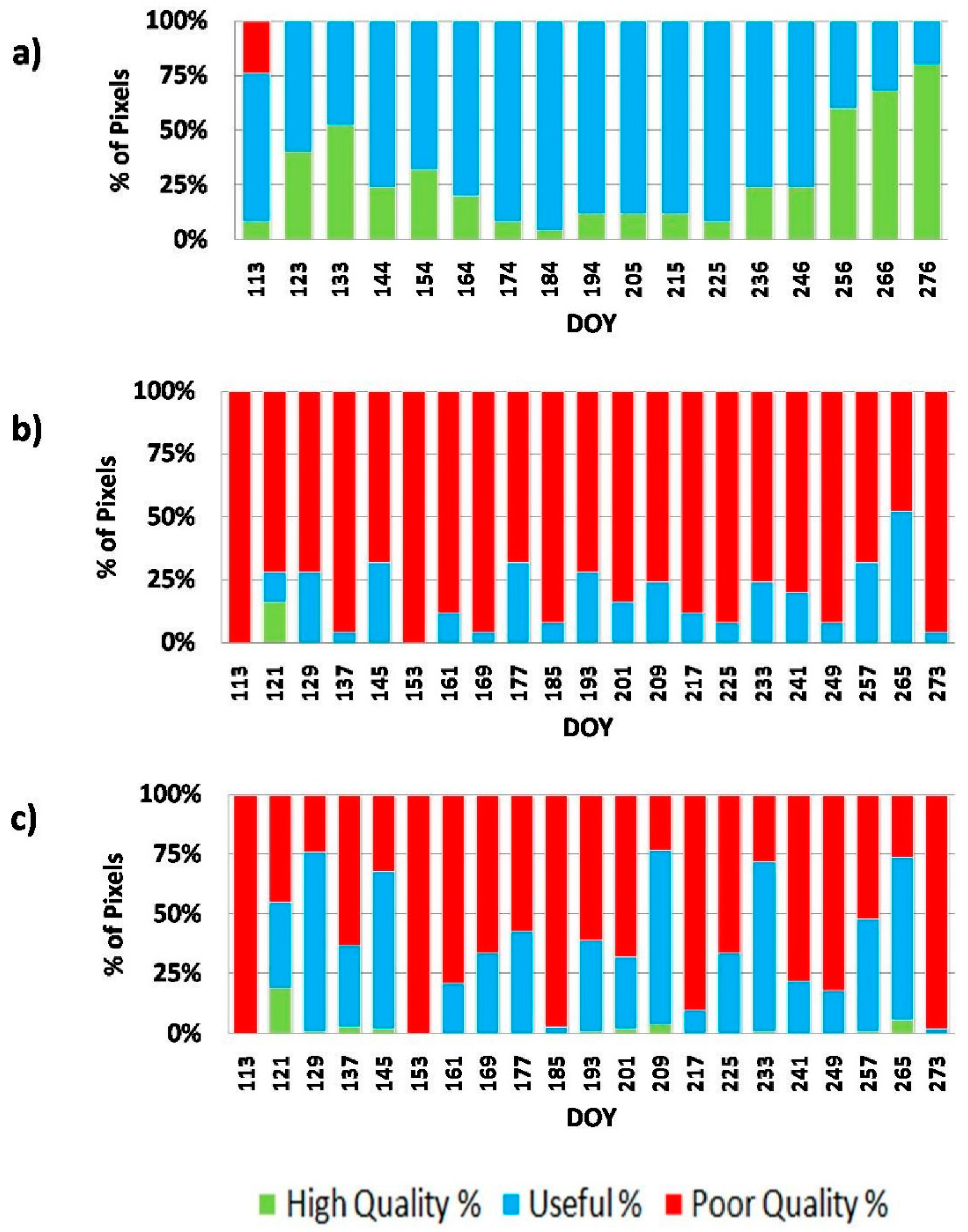
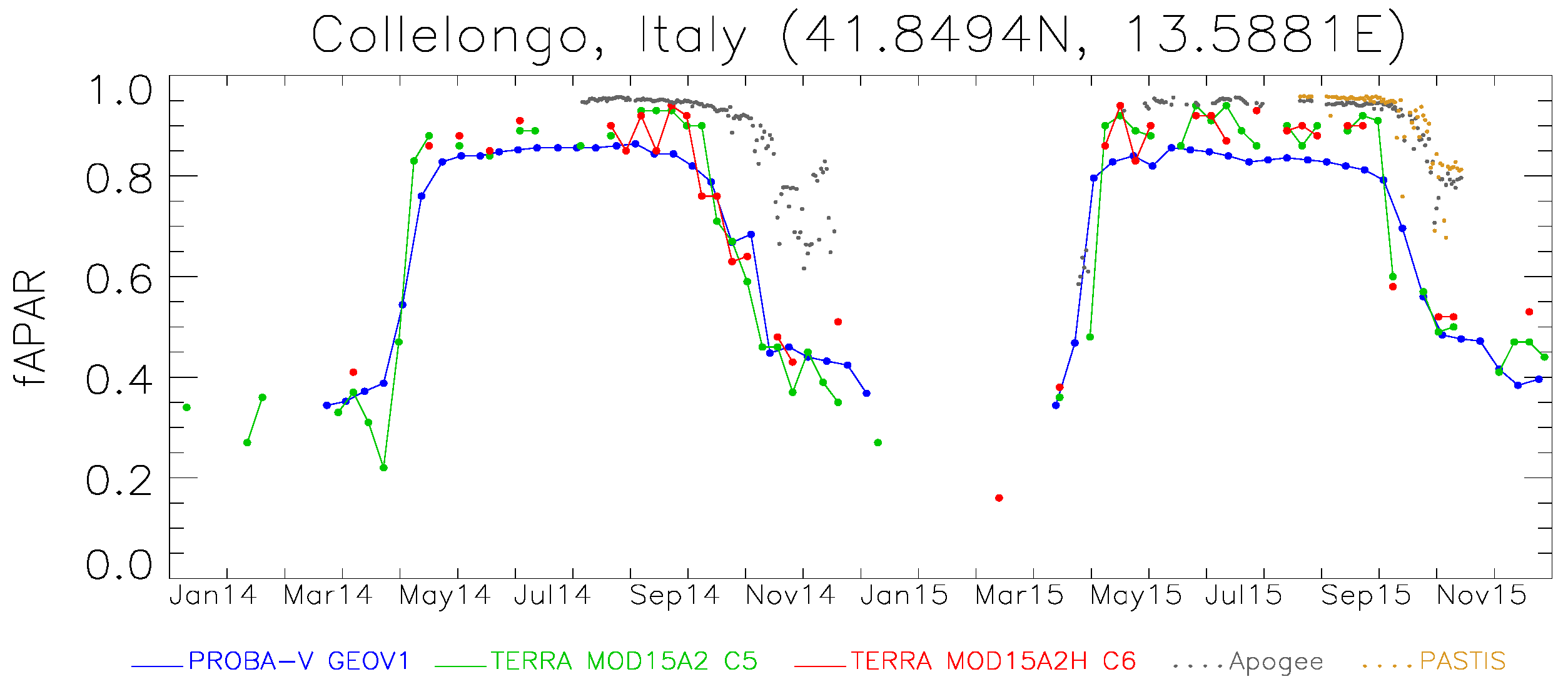
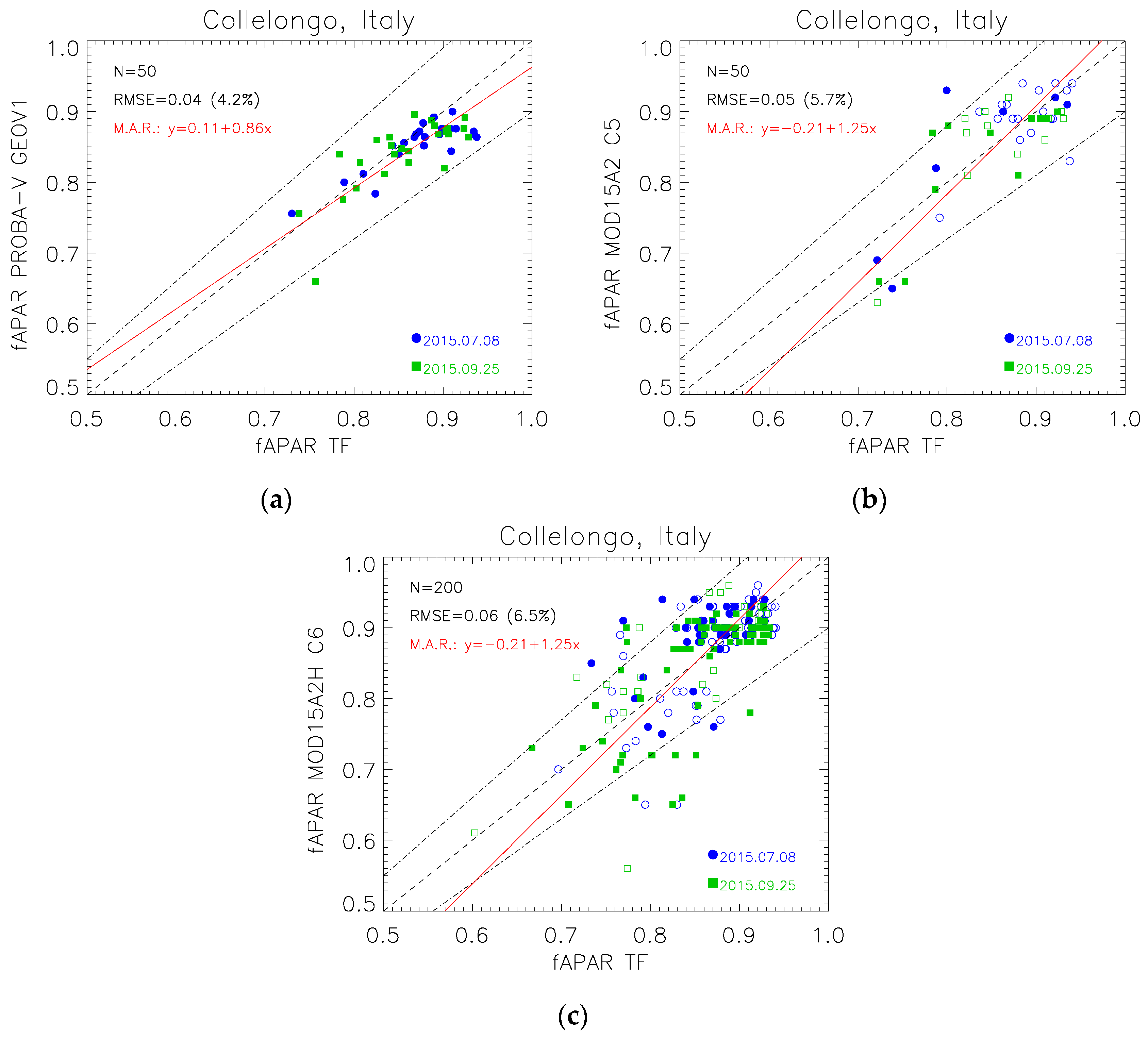
| Product | Sensor | GSD | Frequency | Compositing | Period | Algorithm | Definition | Parametrization | Reference |
|---|---|---|---|---|---|---|---|---|---|
| GEOV1 * | PROBA-V | 1 km | 10-days | 30-days | May 2014–present (*) | ANN trained with CYC and MODIS C5 | Green vegetation, instantaneous black-sky ~10:15 a.m. | Global | Baret et al. [31] |
| MODIS C5 (MOD15A2) | MODIS/TERRA | 1 km | 8-days | 8-days | February 2000–present | Inversion RTM 3D | Green vegetation, instantaneous black-sky 10:30 a.m. | 8 biomes | Knyazikhin et al. [25] |
| MODIS C6 (MOD15A2H) | MODIS/TERRA | 500 m | 8-days | 8-days | February 2000–present | Inversion RTM 3D | Green vegetation, instantaneous black-sky 10:30 a.m. | 8 biomes | Yan et al. [37] |
| QF Layer | High Quality | Useful | Poor Quality | |
|---|---|---|---|---|
| GEOV1 | QFLAG | ‘No Suspect’; Snow Status = ‘Clear’; Input Status = ‘OK’; fAPAR Status = ‘OK’ | ‘Suspect’; Snow Status = ‘Clear’; Input Status = ‘OK’; fAPAR Status = ‘OK’ | Snow Status = ‘Snow’; Input Status = ‘Saturated or Invalid’; fAPAR Status = ‘Out or range or Invalid’ |
| MODIS C5 & MODIS C6 | FaparLaiQC | ‘Main Algorithm’; Cloud State= ‘clear’ | ‘Back-up Algorithm’; Cloud State= ‘clear’ or ‘not defined (assumed clear)’ | ‘Back-up Algorithm’; Cloud State= ‘mixed’ or ‘significant clouds’ |
| FparExtraQC | ‘No snow/ice detected’; | ‘No snow/ice detected’; | ‘Snow/ice detected’; | |
| ‘No cirrus detected’, | ‘No cirrus detected’; | ‘Cirrus was detected’; | ||
| ‘No clouds’; | ‘No clouds’; | ‘Clouds were detected’; | ||
| ‘No cloud shadow detected’ | ‘No cloud shadow detected’ | ‘Cloud shadow detected’ |
| Name of the Sensor | Spatial Sampling | Temporal Sampling | Description |
|---|---|---|---|
| Apogee-PAR | ESU 1 (tower) | July–December 2014 May–December 2015 (daily) | 22 PAR sensors—Continuous measurements |
| PASTIS-PAR | ESUs 1–9 | May–December 2015 (daily) | 10 data logger with 6 PAR sensors each—Continuous measurements |
| Digital camera collecting Digital Hemispheric Photographs (DHPs) | ESUs 1-15 | 8 July 2015 25 September 2015 | 13 DHPs for each ESU |
| Field Campaigns | R2 | Bias | RMSE | RC | RW |
|---|---|---|---|---|---|
| 8 July 2015 | 0.999 | −0.001 | 0.015 | 0.018 | 0.015 |
| 25 September 2015 | 0.995 | −0.009 | 0.041 | 0.063 | 0.062 |
| Both campaigns | 0.995 | −0.003 | 0.03 | 0.049 | 0.025 |
| Gaussian Statistics | Comment |
|---|---|
| N: Number of samples | Indicative of the power of the validation |
| RMSE: Root Mean Square Error | Indicates the Accuracy (Total Error) |
| Relative values between the average of x and y were also computed | |
| B: Mean Bias | Mean difference between pair of values (y–x) |
| Indicative of accuracy and possible offset | |
| Relative values between the average of x and y were also computed | |
| S: Standard deviation | Indicates precision |
| R2: Correlation coefficient. | Indicates descriptive power of the linear accuracy test |
| Pearson coefficient was used | |
| Major Axis Regression (slope, offset) | Indicates possible bias |
| % GCOS requirements | Percentage of pixels matching the GCOS requirements |
| PROBA-V GEOV1 | MODIS C5 (All Points) | MODIS C5 (High Quality and Useful) | MODIS C6 (All Points) | MODIS C6 (High Quality and Useful) | |
|---|---|---|---|---|---|
| N | 50 | 50 | 20 | 200 | 113 |
| RMSE | 0.04 (4.2%) | 0.05 (5.7%) | 0.06 (6.7%) | 0.06 (6.5%) | 0.06 (6.5%) |
| R2 | 0.63 | 0.6 | 0.63 | 0.46 | 0.41 |
| Bias | −0.02 (2.6%) | −0.001 (0.2%) | 0.005 (0.6%) | 0.003 (0.3%) | 0.003 (0.3%) |
| S | 0.03 | 0.05 | 0.06 | 0.06 | 0.06 |
| Offset (MAR) | 0.011 | −0.21 | −0.23 | −0.21 | −0.23 |
| Slope (MAR) | 0.86 | 1.25 | 1.26 | 1.25 | 1.25 |
| % GCOS | 98 | 90 | 85 | 88 | 88 |
© 2017 by the authors. Licensee MDPI, Basel, Switzerland. This article is an open access article distributed under the terms and conditions of the Creative Commons Attribution (CC BY) license ( http://creativecommons.org/licenses/by/4.0/).
Share and Cite
Nestola, E.; Sánchez-Zapero, J.; Latorre, C.; Mazzenga, F.; Matteucci, G.; Calfapietra, C.; Camacho, F. Validation of PROBA-V GEOV1 and MODIS C5 & C6 fAPAR Products in a Deciduous Beech Forest Site in Italy. Remote Sens. 2017, 9, 126. https://doi.org/10.3390/rs9020126
Nestola E, Sánchez-Zapero J, Latorre C, Mazzenga F, Matteucci G, Calfapietra C, Camacho F. Validation of PROBA-V GEOV1 and MODIS C5 & C6 fAPAR Products in a Deciduous Beech Forest Site in Italy. Remote Sensing. 2017; 9(2):126. https://doi.org/10.3390/rs9020126
Chicago/Turabian StyleNestola, Enrica, Jorge Sánchez-Zapero, Consuelo Latorre, Francesco Mazzenga, Giorgio Matteucci, Carlo Calfapietra, and Fernando Camacho. 2017. "Validation of PROBA-V GEOV1 and MODIS C5 & C6 fAPAR Products in a Deciduous Beech Forest Site in Italy" Remote Sensing 9, no. 2: 126. https://doi.org/10.3390/rs9020126






